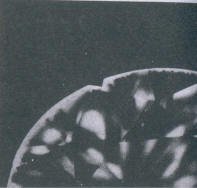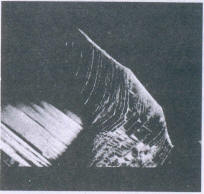The marked cleavability of diamond, of which the cutter makes use in cleaving the stone, can endanger cut diamond because of the risk of external damage; in mounted stones damage can be done by knocks on hard objects, or in the setting or taking the stone out of the setting.
Nicks are small or fairly large, usually wedge-shaped cuts into the girdle (Fig 334-336).
 |
 |
| Fig 334 Nick in the girdle | Fig 335 As Fig 325 seen through the crown |
 |
 |
| Fig 336 Two nicks in the girdle | Fig 337 Fracture in the crown |
They develop during the setting of the stone through pressure or other mechanical stress. They usually follow a direction of cleavage and are occasionally accompanied by tiny internal cleavage cracks.
Fractures also are a consequence of mechanical stress. They occur at the girdle, and more rarely at the point, of the stone when no culet is present. Diamond fractures are very typical, being characterized by a step- or stage-like surface (Fig 337 and 338).
 |
| Fig 338 Fracture showing characteristic step, like surface (30x) |
| Damage | Indentations, damage to edges, scratches |